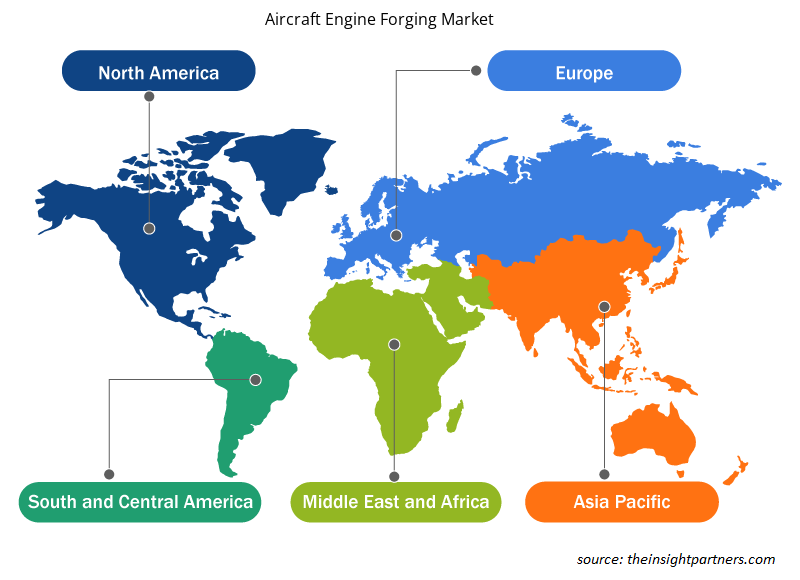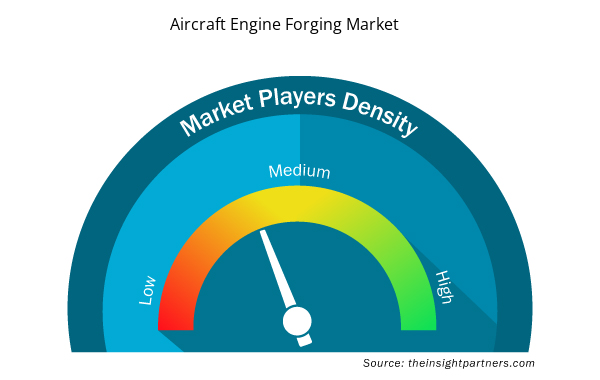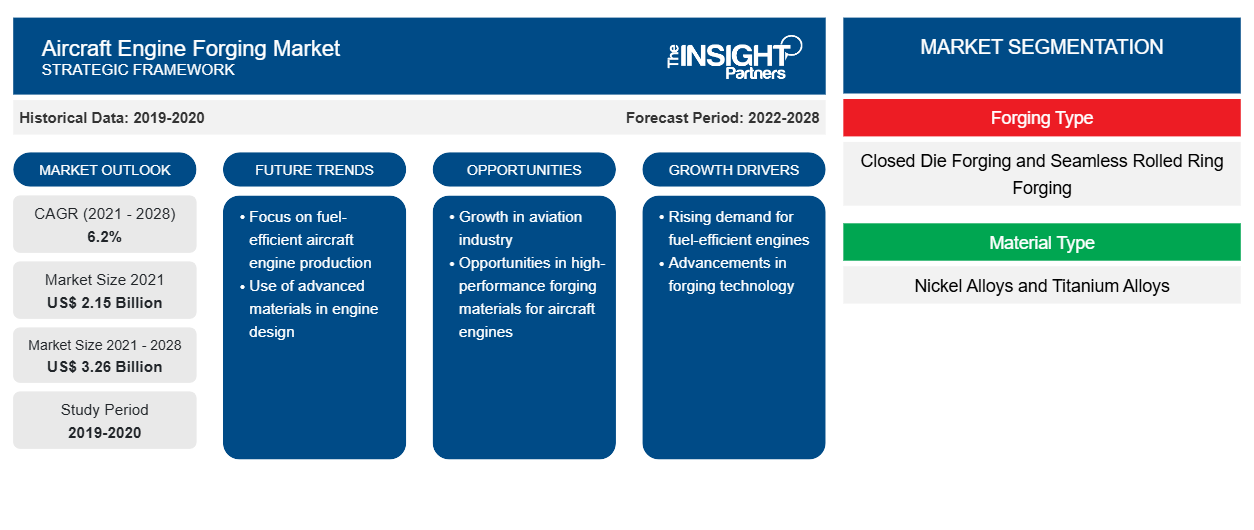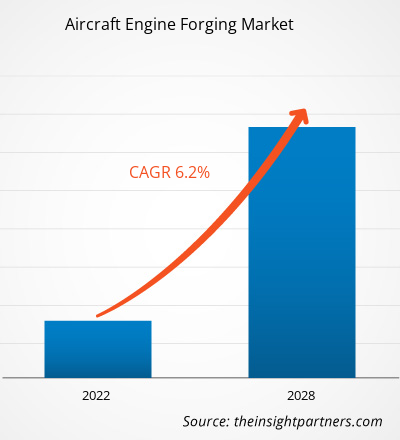Le marché du forgeage des moteurs d'avion devrait atteindre 3 260,77 millions USD d'ici 2028, contre 2 145,80 millions USD en 2021 ; il devrait croître à un TCAC de 6,2 % de 2021 à 2028.
Selon l'Association du transport aérien international, le nombre de passagers aériens devrait quadrupler au cours des deux prochaines décennies. Environ 8,2 milliards de passagers devraient avoir voyagé en avion d'ici 2037. Avec l'augmentation du trafic de passagers, les principaux constructeurs aéronautiques tels qu'Airbus et Boeing s'attendent à une augmentation de leurs livraisons d'avions commerciaux dans les années à venir. Ainsi, l'augmentation du trafic de passagers aériens dans divers pays est un facteur clé qui stimule le marché du forgeage des moteurs d'avion . En outre, la capacité de production d'avions continue d'augmenter en réponse à l'augmentation du trafic aérien et à l'introduction d'avions de nouvelle génération. L'augmentation de la fabrication d'avions stimulerait encore davantage les activités de forgeage de moteurs d'avion. Le processus de forgeage des composants des moteurs d'avion comprend des techniques de travail des métaux et d'usinage telles que le forgeage en matrice fermée, le forgeage en matrice sans soudure et le forgeage isotherme.
Personnalisez ce rapport en fonction de vos besoins
Vous bénéficierez d'une personnalisation gratuite de n'importe quel rapport, y compris de certaines parties de ce rapport, d'une analyse au niveau des pays, d'un pack de données Excel, ainsi que d'offres et de remises exceptionnelles pour les start-ups et les universités.
- Obtenez les principales tendances clés du marché de ce rapport.Cet échantillon GRATUIT comprendra une analyse de données, allant des tendances du marché aux estimations et prévisions.
Impact de la pandémie de COVID-19 sur le marché du forgeage des moteurs d'avion
Les États-Unis ont été les plus durement touchés par la COVID-19 en 2020 et 2021. Les fabricants de moteurs d'avion et de composants de moteurs du pays ont été touchés en raison des confinements et des restrictions de voyage à l'échelle nationale, de la fermeture des installations de production et de la pénurie de personnel. L'épidémie massive du virus a créé à la fois une crise sanitaire et une crise économique aux États-Unis. Elle a entraîné des perturbations majeures dans l'industrie aérospatiale, affectant tout, de la chaîne d'approvisionnement et de la fabrication aux ventes de produits. La pandémie a eu un impact direct et indirect sur les stratégies à court et à long terme de l'industrie.
Informations sur le marché – Marché de la forge des moteurs d’avion
L'Amérique du Nord a connu une hausse de la demande de moteurs d'avion en raison de l'adoption précoce et rapide de moteurs d'avion technologiquement avancés. L'essor de l'industrie aéronautique et de l'aviation de défense dans la région encourage les fabricants de moteurs d'avion à fournir des produits technologiquement innovants et efficaces pour divers types d'avions. L'industrie des moteurs d'avion en Amérique du Nord devrait être stimulée par la demande croissante pour ces moteurs et la présence de plusieurs concurrents majeurs, notamment General Electric Company, Honeywell International Inc., Collins Aerospace et Pratt & Whitney. Ces entreprises entreprennent des activités de R&D vigoureuses pour élargir leurs gammes de produits et fabriquer des moteurs d'avion avec des systèmes, des sous-systèmes et d'autres composants technologiquement améliorés. Ainsi, la croissance de l'industrie des moteurs d'avion soutient la croissance du marché du forgeage de moteurs d'avion en Amérique du Nord.
Informations basées sur le type de matériau
En fonction du type de matériau, la part de marché du forgeage des moteurs d'avion est segmentée en alliage de titane et alliage de nickel. L'alliage de nickel représentait la part la plus élevée en 2020. De nombreuses entreprises de forgeage opérant dans l'industrie aérospatiale (indépendamment du moteur ou des pièces structurelles) sont plus enclines à utiliser des alliages de super nickel. Ces matériaux sont dotés de propriétés de résistance aux températures élevées et à la chaleur. Les alliages de nickel sont utilisés dans les turbines à gaz pour la construction énergétique, les pales, les rotors, les turbomoteurs et les turbines d'avion, les turbines à vapeur, les buses de propulsion, les équipements de traitement, les vannes, les pompes et d'autres pièces qui doivent résister à des environnements critiques. Les alliages de nickel sont idéaux pour les environnements où la température est proche de 1000 degrés F. Désormais, dans un moteur d'avion, les alliages de nickel sont utilisés dans la chambre de combustion et la turbine. En ce qui concerne la température élevée dans la moitié arrière, un alliage à base de fer ou de nickel est utilisé dans un moteur d'avion. La demande d'alliage de nickel est extrêmement élevée dans les techniques de forgeage à matrice fermée et ouverte. Par exemple, Aubert & Duval a récemment développé l'AD730, un nouveau superalliage à base de nickel qui résiste à des températures supérieures à 1 350 °F tout en conservant sa résistance mécanique, sa résistance à la fatigue et au fluage à un coût compétitif.
Le marché du forgeage des moteurs d'avion est segmenté en fonction du type de forgeage, du type de matériau, de l'utilisateur final et de la géographie. En fonction du type, le marché du forgeage des moteurs d'avion est divisé en forgeage en matrice fermée et forgeage en anneau laminé sans soudure. En fonction du type de matériau, le marché est sous-segmenté en alliages de nickel et alliages de titane. En fonction de l'utilisateur final, le marché est encore segmenté en carter de soufflante, carter extérieur de chambre de combustion, disque de turbine, rotors et autres. Sur la base de la géographie, la taille du marché du forgeage des moteurs d'avion est principalement segmentée en Amérique du Nord, Europe, Asie-Pacifique (APAC), Moyen-Orient et Afrique (MEA) et Amérique du Sud et centrale. All Metals & Forge Group, ATI Metals, Doncasters Group Ltd, Farinia Group, Lisi Aerospace, Otto Fuchs GmbH, Pacific Forge Incorporated et Precision Castparts Corp. font partie des principaux acteurs présentés lors de l'étude du marché du forgeage des moteurs d'avion.
Aperçu régional du marché du forgeage des moteurs d'avion
Les tendances et facteurs régionaux influençant le marché du forgeage des moteurs d’aéronefs tout au long de la période de prévision ont été expliqués en détail par les analystes d’Insight Partners. Cette section traite également des segments et de la géographie du marché du forgeage des moteurs d’aéronefs en Amérique du Nord, en Europe, en Asie-Pacifique, au Moyen-Orient et en Afrique, ainsi qu’en Amérique du Sud et en Amérique centrale.

- Obtenez les données régionales spécifiques au marché du forgeage des moteurs d'avion
Portée du rapport sur le marché du forgeage des moteurs d'avion
| Attribut de rapport | Détails |
|---|---|
| Taille du marché en 2021 | 2,15 milliards de dollars américains |
| Taille du marché d'ici 2028 | 3,26 milliards de dollars américains |
| Taux de croissance annuel moyen mondial (2021-2028) | 6,2% |
| Données historiques | 2019-2020 |
| Période de prévision | 2022-2028 |
| Segments couverts | Par type de forge
|
| Régions et pays couverts | Amérique du Nord
|
| Leaders du marché et profils d'entreprises clés |
|
Densité des acteurs du marché : comprendre son impact sur la dynamique des entreprises
Le marché du forgeage des moteurs d'avion connaît une croissance rapide, tirée par la demande croissante des utilisateurs finaux en raison de facteurs tels que l'évolution des préférences des consommateurs, les avancées technologiques et une plus grande sensibilisation aux avantages du produit. À mesure que la demande augmente, les entreprises élargissent leurs offres, innovent pour répondre aux besoins des consommateurs et capitalisent sur les tendances émergentes, ce qui alimente davantage la croissance du marché.
La densité des acteurs du marché fait référence à la répartition des entreprises ou des sociétés opérant sur un marché ou un secteur particulier. Elle indique le nombre de concurrents (acteurs du marché) présents sur un marché donné par rapport à sa taille ou à sa valeur marchande totale.
Les principales entreprises opérant sur le marché du forgeage de moteurs d'avions sont :
- Groupe Tous Métaux et Forges
- ATI
- Doncaster Group Ltd
- Groupe Farinia
- Lisi Aerospace
Avis de non-responsabilité : les sociétés répertoriées ci-dessus ne sont pas classées dans un ordre particulier.

- Obtenez un aperçu des principaux acteurs du marché du forgeage des moteurs d'avion
Les acteurs opérant sur le marché du forgeage de moteurs d’avions se concentrent principalement sur le développement de produits avancés et efficaces.
- En 2019, Doncasters a vendu ses deux entreprises implantées à Sheffield, Shrewsbury et Blaenavon. Blaenavon Forgings est vendue à la société de capital-investissement américaine Arlington Capital Partners et son activité UK Fabrications à Radius Aerospace.
- En 2018, LISI Aerospace a développé dans son usine des Forges de Bologne une technologie de forgeage « matrices à chaud ». Ce nouveau concept permet de maintenir la productivité du forgeage conventionnel tout en obtenant une qualité métallurgique proche de celle des pièces forgées en isotherme, c’est-à-dire une installation de forgeage fonctionnant à 1 250/1 300°C, en termes d’homogénéité de la microstructure et de santé externe des pièces.
- Analyse historique (2 ans), année de base, prévision (7 ans) avec TCAC
- Analyse PEST et SWO
- Taille du marché Valeur / Volume - Mondial, Régional, Pays
- Industrie et paysage concurrentiel
- Ensemble de données Excel


- Clear Aligners Market
- Smart Water Metering Market
- Aircraft MRO Market
- Cosmetic Bioactive Ingredients Market
- Online Exam Proctoring Market
- Public Key Infrastructure Market
- Predictive Maintenance Market
- Europe Surety Market
- Trade Promotion Management Software Market
- Intraoperative Neuromonitoring Market

Report Coverage
Revenue forecast, Company Analysis, Industry landscape, Growth factors, and Trends

Segment Covered
This text is related
to segments covered.

Regional Scope
North America, Europe, Asia Pacific, Middle East & Africa, South & Central America

Country Scope
This text is related
to country scope.
Questions fréquemment posées
The global aviation industry is experiencing huge demand for air travel, for both military and commercial purposes. This is leading the aircraft manufacturers to procure the latest aircraft models, and models and adopt new and robust technologies. Therefore, the production of the next generation of aircraft is expected to be one of the key trends in the aviation industry in the future. The trend is predicted to pitch over the period, leading to huge opportunities for the proliferation of aircraft component forging players
China dominated the APAC aircraft engine forging market in 2020. With a rising population in China, the adoption of air transportation is also growing. The plan of China related to the procurement of new helicopters is increased by 9%, which provides more opportunities to the engine forging companies. The aviation industry is among the top ten key areas of focus in the “Made in China 2025†initiative. To achieve this pre-determined goal, the country is heavily dependent on imported engines, avionics, and other critical components/parts. These ‘one-generation-behind’ new aircraft are projected to assist in the growth of China.
ATI Metals, Safran, Precision Castparts Corp., Arconic, and Otto Fuchs are the five key market players operating in the global aircraft engine forging market. We have derived this listing of “Key Five Players†in the global aircraft engine forging market by giving weightage to the following key parameters: overall revenue, segmental revenue, brand image & industry experience, current geotechnical construction services portfolio, customer base, geographical reach, partnerships, mergers & acquisitions, and other market-related activities.
The aircraft engine forging market is dominated by closed die forging segment which held a market share of 62.5% in 2020 and is anticipated to continue its dominance during the forecast period to account for 58.4% of the aircraft engine forging market share by 2028.
The rise in the manufacturing of aircraft is directly magnifying the demand for aircraft engines over years. Additionally, airlines, aircraft operators, armed forces, and charter operators are likely to boost the demand for new engines as part of their fleet modernization and growth plans. The growing need for a new generation of engines with low emissions and weight, which would improve airplane fuel efficiency, is also contributing to the aircraft engine forging market proliferation.
North America held the largest share of the global aircraft engine forging market. North America has experienced a rise in demand for aircraft engines due to the early and rapid adoption of technologically advanced airplane engines. The booming aerospace and defense aviation business in the region encourages aircraft engine manufacturers to provide technologically innovative and efficient products for various aircraft types. The aircraft engine industry in North America is likely to be driven by rising demand for these engines and the presence of several major competitors, including General Electric Company, Honeywell International Inc., Collins Aerospace, and Pratt & Whitney. These companies undertake vigorous R&D activities to expand their product lines and manufacture aircraft engines with technologically improved systems, subsystems, and other components. Thus, the growth of the aircraft engine industry is supporting the growth of the aircraft engine forging market across North America.
Trends and growth analysis reports related to Aerospace and Defense : READ MORE..
The List of Companies - Aircraft Engine Forging Market
- All Metals and Forge Group
- ATI
- Doncaster Group Ltd
- Farinia Group
- Lisi Aerospace
- Otto Fuchs GmbH
- Pacific Forge Incorporated
- Precision Castparts Corp.
- Safran
- VSMPO-AVISMA Corporation
The Insight Partners performs research in 4 major stages: Data Collection & Secondary Research, Primary Research, Data Analysis and Data Triangulation & Final Review.
- Data Collection and Secondary Research:
As a market research and consulting firm operating from a decade, we have published and advised several client across the globe. First step for any study will start with an assessment of currently available data and insights from existing reports. Further, historical and current market information is collected from Investor Presentations, Annual Reports, SEC Filings, etc., and other information related to company’s performance and market positioning are gathered from Paid Databases (Factiva, Hoovers, and Reuters) and various other publications available in public domain.
Several associations trade associates, technical forums, institutes, societies and organization are accessed to gain technical as well as market related insights through their publications such as research papers, blogs and press releases related to the studies are referred to get cues about the market. Further, white papers, journals, magazines, and other news articles published in last 3 years are scrutinized and analyzed to understand the current market trends.
- Primary Research:
The primarily interview analysis comprise of data obtained from industry participants interview and answers to survey questions gathered by in-house primary team.
For primary research, interviews are conducted with industry experts/CEOs/Marketing Managers/VPs/Subject Matter Experts from both demand and supply side to get a 360-degree view of the market. The primary team conducts several interviews based on the complexity of the markets to understand the various market trends and dynamics which makes research more credible and precise.
A typical research interview fulfils the following functions:
- Provides first-hand information on the market size, market trends, growth trends, competitive landscape, and outlook
- Validates and strengthens in-house secondary research findings
- Develops the analysis team’s expertise and market understanding
Primary research involves email interactions and telephone interviews for each market, category, segment, and sub-segment across geographies. The participants who typically take part in such a process include, but are not limited to:
- Industry participants: VPs, business development managers, market intelligence managers and national sales managers
- Outside experts: Valuation experts, research analysts and key opinion leaders specializing in the electronics and semiconductor industry.
Below is the breakup of our primary respondents by company, designation, and region:

Once we receive the confirmation from primary research sources or primary respondents, we finalize the base year market estimation and forecast the data as per the macroeconomic and microeconomic factors assessed during data collection.
- Data Analysis:
Once data is validated through both secondary as well as primary respondents, we finalize the market estimations by hypothesis formulation and factor analysis at regional and country level.
- Macro-Economic Factor Analysis:
We analyse macroeconomic indicators such the gross domestic product (GDP), increase in the demand for goods and services across industries, technological advancement, regional economic growth, governmental policies, the influence of COVID-19, PEST analysis, and other aspects. This analysis aids in setting benchmarks for various nations/regions and approximating market splits. Additionally, the general trend of the aforementioned components aid in determining the market's development possibilities.
- Country Level Data:
Various factors that are especially aligned to the country are taken into account to determine the market size for a certain area and country, including the presence of vendors, such as headquarters and offices, the country's GDP, demand patterns, and industry growth. To comprehend the market dynamics for the nation, a number of growth variables, inhibitors, application areas, and current market trends are researched. The aforementioned elements aid in determining the country's overall market's growth potential.
- Company Profile:
The “Table of Contents” is formulated by listing and analyzing more than 25 - 30 companies operating in the market ecosystem across geographies. However, we profile only 10 companies as a standard practice in our syndicate reports. These 10 companies comprise leading, emerging, and regional players. Nonetheless, our analysis is not restricted to the 10 listed companies, we also analyze other companies present in the market to develop a holistic view and understand the prevailing trends. The “Company Profiles” section in the report covers key facts, business description, products & services, financial information, SWOT analysis, and key developments. The financial information presented is extracted from the annual reports and official documents of the publicly listed companies. Upon collecting the information for the sections of respective companies, we verify them via various primary sources and then compile the data in respective company profiles. The company level information helps us in deriving the base number as well as in forecasting the market size.
- Developing Base Number:
Aggregation of sales statistics (2020-2022) and macro-economic factor, and other secondary and primary research insights are utilized to arrive at base number and related market shares for 2022. The data gaps are identified in this step and relevant market data is analyzed, collected from paid primary interviews or databases. On finalizing the base year market size, forecasts are developed on the basis of macro-economic, industry and market growth factors and company level analysis.
- Data Triangulation and Final Review:
The market findings and base year market size calculations are validated from supply as well as demand side. Demand side validations are based on macro-economic factor analysis and benchmarks for respective regions and countries. In case of supply side validations, revenues of major companies are estimated (in case not available) based on industry benchmark, approximate number of employees, product portfolio, and primary interviews revenues are gathered. Further revenue from target product/service segment is assessed to avoid overshooting of market statistics. In case of heavy deviations between supply and demand side values, all thes steps are repeated to achieve synchronization.
We follow an iterative model, wherein we share our research findings with Subject Matter Experts (SME’s) and Key Opinion Leaders (KOLs) until consensus view of the market is not formulated – this model negates any drastic deviation in the opinions of experts. Only validated and universally acceptable research findings are quoted in our reports.
We have important check points that we use to validate our research findings – which we call – data triangulation, where we validate the information, we generate from secondary sources with primary interviews and then we re-validate with our internal data bases and Subject matter experts. This comprehensive model enables us to deliver high quality, reliable data in shortest possible time.


 Obtenez un échantillon gratuit pour ce rapport
Obtenez un échantillon gratuit pour ce rapport